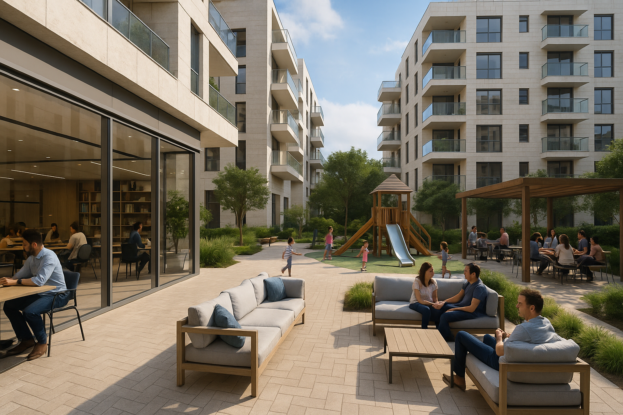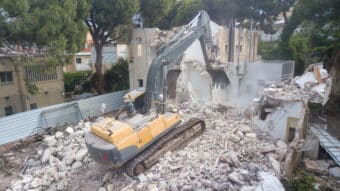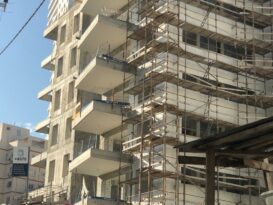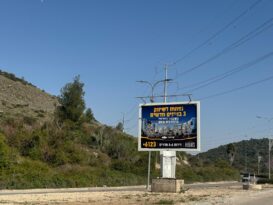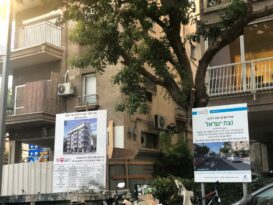As lifestyles evolve around the world, housing in Israel is being redefined to meet the needs of the future. Homes are now expected to serve multiple functions — including remote work, family life, community involvement, and religious practice. These shifts are influencing how residential buildings are designed, what amenities they include, and where they are located. This article explores how developers are adapting through urban renewal, mixed-use planning, and a growing focus on functionality, flexibility, and quality of life.
In recent years, housing in Israel has undergone a quiet revolution. The way Israelis live, work, and interact with their homes has shifted dramatically — accelerated by the COVID-19 pandemic, influenced by the current security situation, and shaped by evolving values around work-life balance, family, and community. These lifestyle changes are leaving a lasting mark on residential architecture and urban planning across the country.
In response, Israeli developers are reimagining what it means to build a home and redefining housing in Israel for a new generation. They are designing mixed-use spaces that serve as complete ecosystems: places to live, work, raise children, connect with others, and find peace in uncertain times. Today’s residential projects are increasingly designed to support the full spectrum of modern life, with everything from co-working spaces and stroller rooms to rooftop gardens and community lounges built in from the start.
Work-From-Home? Work-From-Building!
The most noticeable shift in recent years has been in how people work. The rise of remote and hybrid work models has transformed the role of the home: it’s no longer just a place to relax after the workday, but the very setting in which the workday unfolds. As a result, more and more residential projects are incorporating shared workspaces: co-working lounges inspired by the WeWork model, offering high-speed internet, meeting rooms, printing stations, and quiet zones.
For many Israelis — particularly young professionals and parents — these shared work areas have become a lifesaver, providing a professional environment just steps from home. They’re also an efficient use of space in cities where apartments are often modest in size. Developers began seeing demand for co-working spaces in residential buildings during COVID, and that demand has remained steady. Buyers increasingly expect the flexibility to work from home, but not necessarily from their kitchen.
Designing for Connection and Community
With people spending more time at home, there’s a growing emphasis on community, accessibility, and shared living experiences. New residential buildings increasingly offer amenities designed to bring residents together: synagogues and batei midrash for prayer and study, children’s playrooms, and multipurpose rooms for events, classes, or holiday gatherings.
These communal areas are particularly attractive to families with young children, as well as to olim (immigrants), who often seek opportunities to meet neighbors and build connections quickly. Developers have responded to this demand by marketing buildings not just for their location or finishes, but for the lifestyle and community they offer. Today, buyers are looking for more than just an apartment — they’re looking for a lifestyle that includes synagogues, community rooms, and play areas as essential components.
Building Religion into Everyday Living
In neighborhoods with strong religious or traditional communities, developers are increasingly incorporating elements that support Jewish spiritual life as part of the building’s design. In addition to synagogues and batei midrash, many new projects include shared sukkah balconies or rooftop areas where residents can conveniently celebrate the holiday of Sukkot, even when private balconies are too small or not included in the plans. In some upscale or high-density buildings, plans may even include a mikvah for ritual immersion, offering unparalleled convenience for observant families.
These features reflect a growing awareness that for many buyers, a home is not just about physical space — it’s about creating a lifestyle that integrates religion, tradition, and community seamlessly into everyday life.
Modern Families, Modern Needs
As important as it is to accommodate traditional living, the ever-changing needs of modern families are reflected in how new homes are planned and equipped. Features like dedicated stroller and bike storage, secure playgrounds, and indoor-outdoor gathering areas are now seen as essential in family-friendly buildings.
Some larger developments even include on-site kindergartens or daycares, and in an age when many families do not have private gardens or large balconies, shared courtyards and green spaces are stepping in to serve as places where children can run freely and parents can sit together in the shade.
With a growing awareness of the importance of physical and mental well-being, especially in urban environments, many developers are introducing wellness-focused amenities, such as outdoor yoga decks, small fitness studios, walking trails within private complexes, and swimming pools that offer both recreation and relief.
How Urban Renewal is Shaping Tomorrow’s Neighborhoods
Much of this innovation is being driven by urban renewal, commonly referred to in Israel as pinui-binui. Demolishing outdated buildings and rebuilding from scratch allows developers to rethink layout, density, green space, accessibility, and long-term livability.
One of the most transformative shifts underway is the rise of mixed-use developments — projects that integrate residential buildings with essential commercial services such as grocery stores, pharmacies, clinics, cafés, and more. These micro-neighborhoods reflect the global trend toward “15-minute cities,” where everything needed for daily life is within walking distance. They support convenience, reduce dependence on cars, and help create vibrant, walkable communities.
Many of these developments are being strategically located above or adjacent to light rail lines and future metro stations, offering seamless access to public transportation. These transit-oriented projects are part of a broader national push to ease congestion, reduce emissions, and improve quality of life through greener urban mobility.
A New Vision of Home in Israel
Across Israel, a new vision of home is taking shape — one that reflects how people live today, and anticipates how they’ll live tomorrow. This transformation is being led not only by changing demographics and technological shifts, but also by a renewed focus on community, purpose, and adaptability. As developers continue to respond with creativity and intention, they’re not just building places to live — they’re shaping the future of Israeli society, one home at a time.
The Buyitinisrael Editorial team is made up of industry experts, journalists, researchers, editors, and translators working together to deliver reliable, up-to-date information about the Israeli property market — all in English. With a strong focus on transparency and accessibility, our goal is to empower English-speaking buyers by helping them understand the market and navigate the real estate process with clarity and confidence.
For inquiries, email info@buyitinisrael.com.
